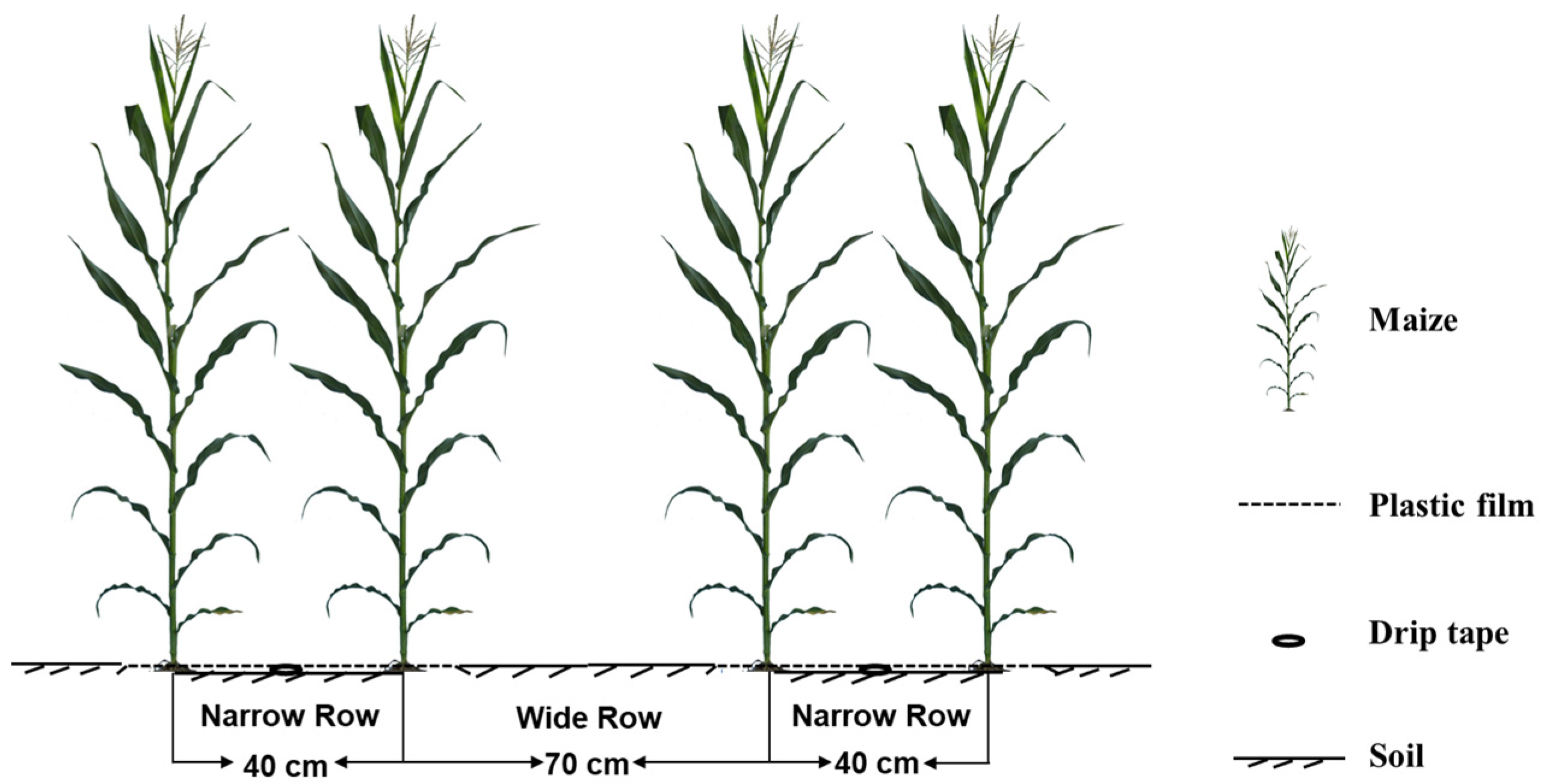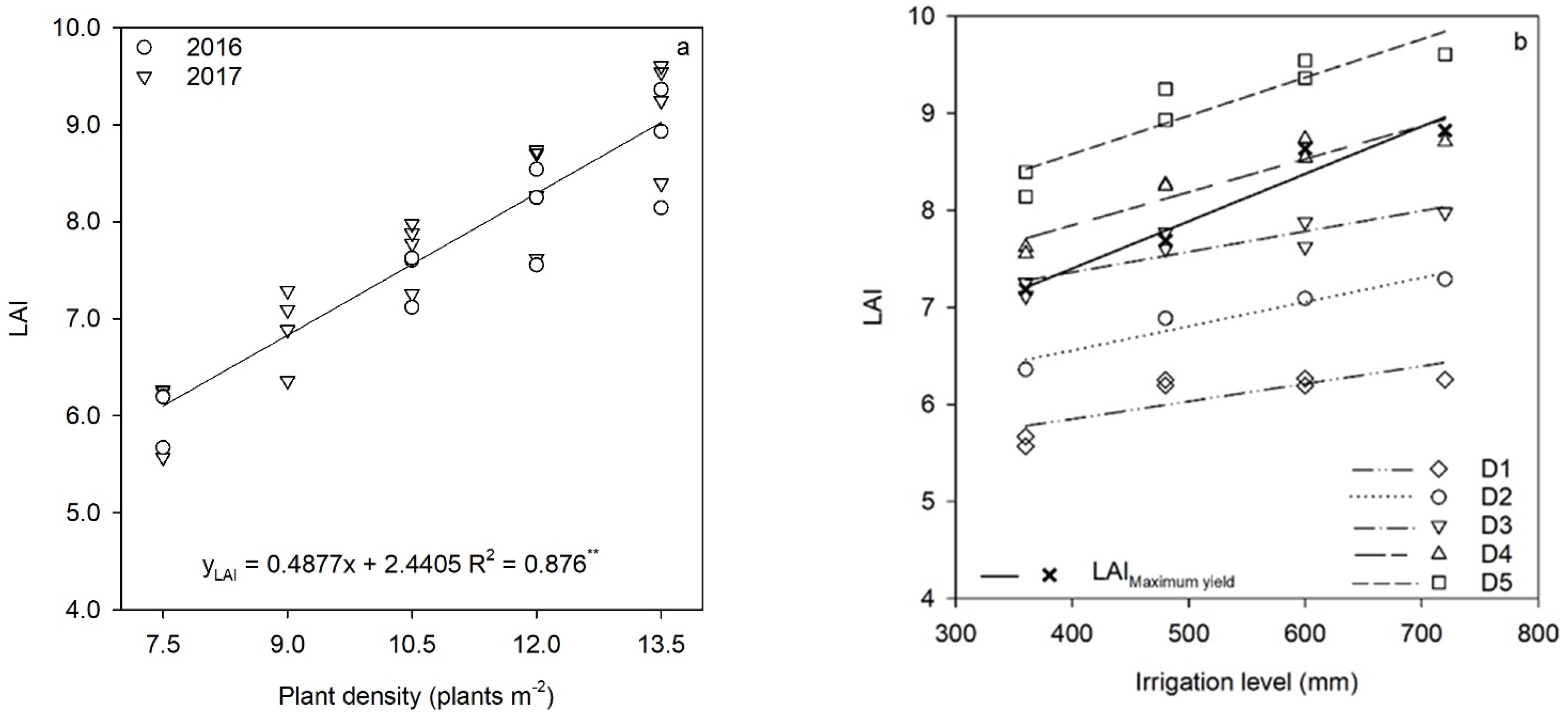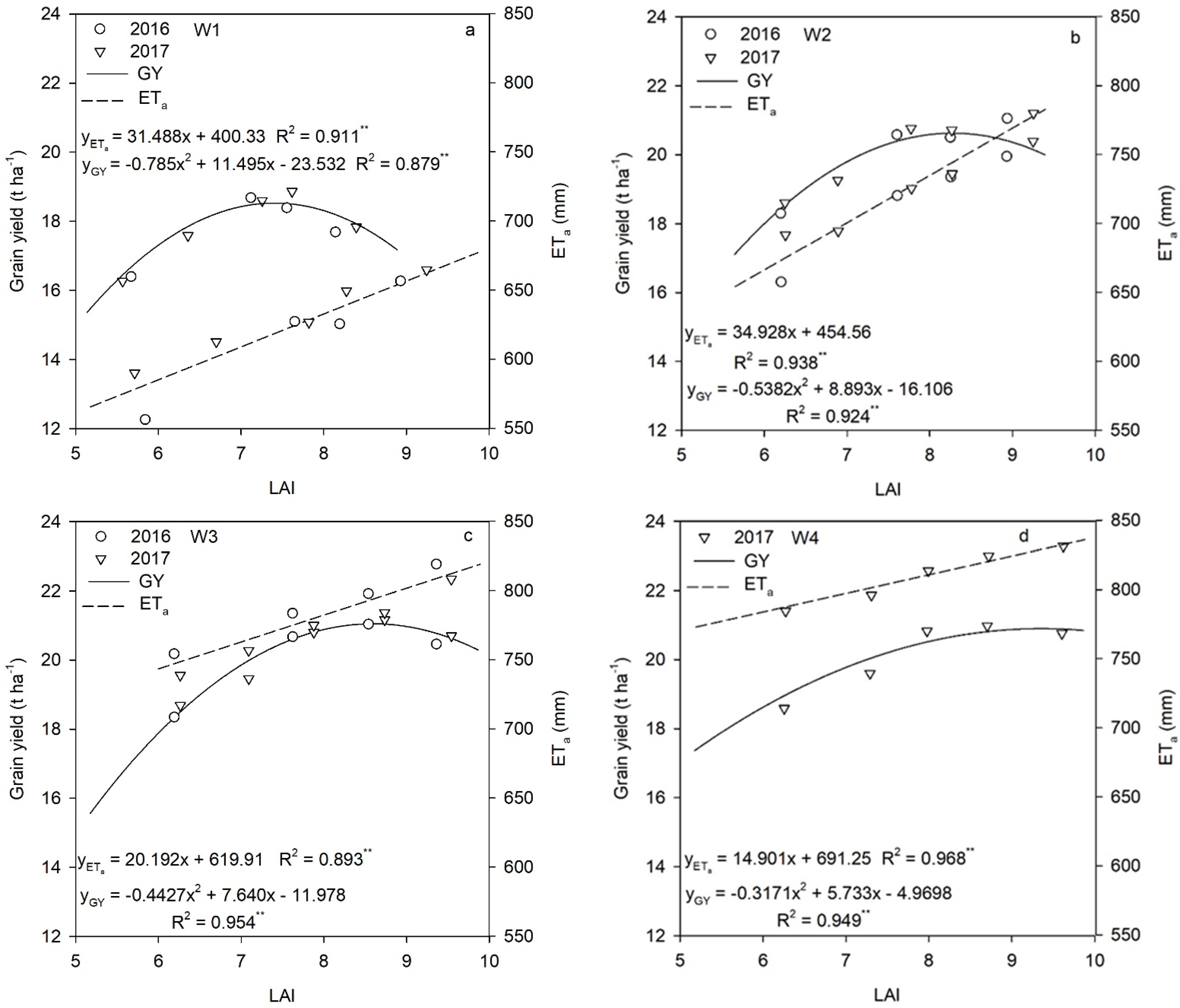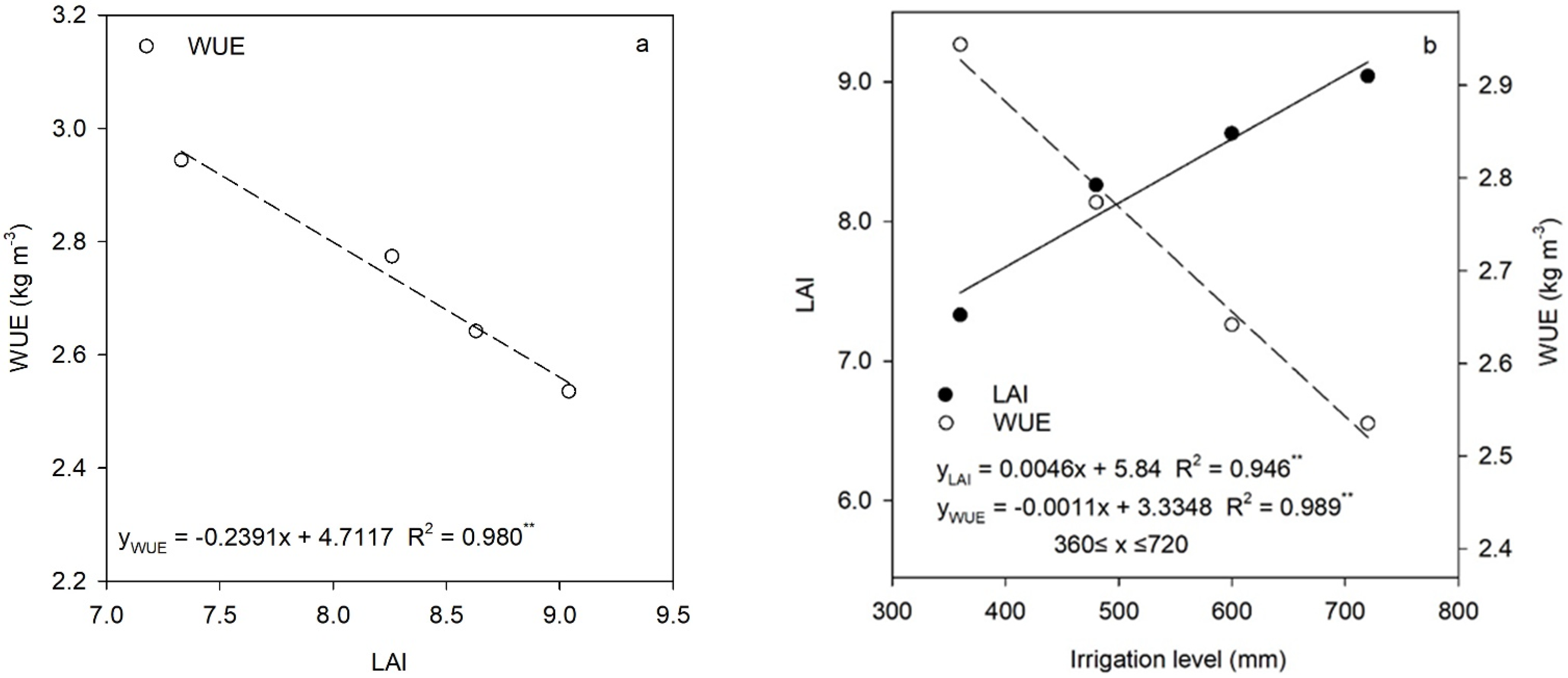Optimizing Grain Yield and Water Use Efficiency Based on the Relationship between Leaf Area Index and Evapotranspiration
Abstract
1. Introduction
2. Materials and Methods
2.1. Experimental Region and Site
2.2. Experimental Design
2.3. Irrigation System and Agronomic Practices
2.4. Sampling and Measurements
2.5. Statistical Analysis
3. Results
3.1. Grain Yield, Kernel Number, Kernel Weight, ETa, and WUE
3.2. Relationship between Grain Yield and Plant Density
3.3. Relationships between LAI and Plant Density, and LAI and Irrigation Level
3.4. LAI, Grain Yield, and ETa
3.5. Theoretical Optimal Irrigation Level, LAI, and WUE
4. Discussion
4.1. The Balance between Agricultural Production and Its Environmental Impacts
4.2. Effects of Density and Irrigation on Grain Yield
4.3. Ways to Increase Grain Yield and Production Efficiency in the Future
5. Conclusions
Author Contributions
Funding
Data Availability Statement
Acknowledgments
Conflicts of Interest
References
- Li, S.K.; Zhao, J.R.; Dong, S.T.; Zhao, M.; Li, C.H.; Cui, Y.H.; Liu, Y.H.; Gao, J.L.; Xue, J.Q.; Wang, L.C.; et al. Advances and Prospects of Maize Cultivation in China. Sci. Agric. Sin. 2017, 50, 1941–1959. [Google Scholar]
- Tollenaar, M.; Lee, E.A. Yield potential, yield stability and stress tolerance in maize. Field Crops Res. 2002, 75, 161–169. [Google Scholar] [CrossRef]
- Grassini, P.; Thorburn, J.; Burr, C.; Cassman, K.G. High–yield irrigated maize in the Western U.S. Corn Belt: I. On–farm yield, yield potential, and impact of agronomic practices. Field Crops Res. 2011, 120, 142–150. [Google Scholar] [CrossRef]
- Brekke, B.; Edwards, J.; Knapp, A. Selection and adaptation to high plant density in the Iowa Stiff Stalk Synthetic maize (Zea mays L.) population. Crop Sci. 2011, 51, 1965–1967. [Google Scholar] [CrossRef]
- Sangoi, L.; Gracietti, M.A.; Rampazzo, C.; Bianchetti, P. Response of Brazilian maize hybrids from different ears to changes in plant density. Field Crops Res. 2002, 79, 39–51. [Google Scholar] [CrossRef]
- Li, J.; Xie, R.Z.; Wang, K.R.; Ming, B.; Guo, Y.Q.; Zhang, G.Q.; Li, S.K. Variations in maize dry matter, harvest index, and grain yield with plant density. Agron. J. 2015, 107, 829–834. [Google Scholar] [CrossRef]
- Li, J.; Xie, R.Z.; Wang, K.R.; Hou, P.; Ming, B.; Zhang, G.Q.; Liu, G.Z.; Wu, M.; Yang, Z.S.; Li, S.K. Response of canopy structure, light interception and grain yield to plant density in maize. J. Agr. Sci. 2018, 156, 785–794. [Google Scholar] [CrossRef]
- Hammer, G.L.; Dong, Z.; McLean, G.; Doherty, A.; Messina, C.; Schussler, J.; Zinselmeier, C.; Paszkiewicz, S.; Cooper, M. Can changes in canopy and/or root system architecture explain historical maize yield trends in the U.S. Corn Belt? Crop Sci. 2009, 49, 299–312. [Google Scholar] [CrossRef]
- Kang, S.Z.; Hao, X.M.; Du, T.S.; Tong, L.; Su, X.L.; Lu, H.N.; Li, X.L.; Huo, Z.L.; Li, S.E.; Ding, R.S. Improving agricultural water productivity to ensure food security in China under changing environment: From research to practice. Agric. Water Manag. 2017, 179, 5–17. [Google Scholar] [CrossRef]
- Ata-Ul-Karim, S.T.; Zhu, Y.; Yao, X.; Cao, W. Determination of critical nitrogen dilution curve based on leaf area index in rice. Field Crops Rese. 2014, 167, 76–85. [Google Scholar] [CrossRef]
- Xu, W.J.; Liu, C.W.; Wang, K.R.; Xie, R.Z.; Ming, B.; Wang, Y.H.; Zhang, G.Q.; Liu, G.Z.; Zhao, R.L.; Fan, P.P.; et al. Adjusting maize plant density to different climatic conditions across a large longitudinal distance in China. Field Crops Res. 2017, 212, 126–134. [Google Scholar] [CrossRef]
- Eldaw Elwadie, M.; Pierce, F.J.; Qi, J. Remote sensing of canopy dynamics and biophysical variables estimation of corn in Michigan. Agron. J. 2005, 97, 99–105. [Google Scholar] [CrossRef]
- Tetio–Kagho, F.; Gardner, F.P. Responses of maize to plant population density. I. Canopy development, light relationships, and vegetative growth. Agron. J. 1988, 80, 930–935. [Google Scholar] [CrossRef]
- Srinivasan, V.; Kumar, P.; Long, S.P. Decreasing, not increasing, leaf area will raise crop yields under global atmospheric change. Glob. Change Biol. 2017, 23, 1626–1635. [Google Scholar] [CrossRef]
- Jia, Q.M.; Sun, L.F.; Wang, J.J.; Li, J.; Ali, S.; Liu, T.N.; Zhang, P.; Lian, Y.H.; Ding, R.X.; Ren, X.L.; et al. Effect of plant density and pattern on maize yield and rainwater use efficiency in the Loess Plateau in China. Agric. Water Manag. 2018, 202, 19–32. [Google Scholar] [CrossRef]
- Yan, H.; Wang, S.Q.; Billesbach, D.; Oechel, W.; Zhang, J.H.; Meyers, T.; Martin, T.A.; Matamala, R.; Baldocchi, D.; Bohrer, G.; et al. Global estimation of evapotranspiration using a leaf area index-based surface energy and water balance model. Remote Sens Environ. 2012, 124, 581–595. [Google Scholar] [CrossRef]
- Jiang, X.L.; Kang, S.Z.; Tong, L.; Li, F.S.; Li, D.H.; Ding, R.S.; Qiu, R.J. Crop coefficient and evapotranspiration of grain maize modified by plant density in an arid region of northwest China. Agric. Water Manag. 2014, 142, 135–143. [Google Scholar] [CrossRef]
- Wallace, J.S. Increasing agricultural water use efficiency to meet future food production. Agric. Ecosyst. Environ. 2002, 82, 105–119. [Google Scholar] [CrossRef]
- Howell, T.A. Enhancing Water Use Efficiency in Irrigated Agriculture. Agron. J. 2001, 93, 281–289. [Google Scholar] [CrossRef]
- Zhang, G.Q.; Shen, D.P.; Ming, B.; Xie, R.Z.; Jin, X.L.; Liu, C.W.; Hou, P.; Xue, J.; Chen, J.L.; Zhang, W.X.; et al. Using irrigation intervals to optimize water-use efficiency and maize yield in Xinjiang, northwest China. Crop J. 2019, 7, 322–334. [Google Scholar] [CrossRef]
- Zhao, J.; Xue, Q.; Jessup, K.E.; Hao, B.; Hou, X.; Marek, T.H.; Xu, W.; Evett, S.R.; O’Shaughnessy, S.A.; Brauer, D.K. Yield and water use of drought–tolerant maize hybrids in a semiarid environment. Field Crops Res. 2018, 216, 1–9. [Google Scholar] [CrossRef]
- Sun, D.B.; Li, H.G.; Wang, E.L.; He, W.Q.; Hao, W.P.; Yan, C.R.; Li, Y.Z.; Mei, X.R.; Zhang, Y.Q.; Sun, Z.X.; et al. An overview of the use of plastic–film mulching in China to increase crop yield and water–use efficiency. Natl. Sci. Rev. 2020, 7, 1523–1526. [Google Scholar] [CrossRef]
- Zheng, J.; Fan, J.L.; Zhang, F.C.; Zhuang, Q.L. Evapotranspiration partitioning and water productivity of rainfed maize under contrasting mulching conditions in Northwest China. Agric. Water Manag. 2021, 243, 106473. [Google Scholar] [CrossRef]
- Sun, L.; Wang, S.L.; Zhang, Y.J.; Li, J.; Wang, X.L.; Wang, R.; Lyu, W.; Chen, N.N.; Wang, Q. Conservation agriculture based on crop rotation and tillage in the semi-arid Loess Plateau, China: Effects on crop yield and soil water use. Agric. Ecosyst. Environ. 2018, 251, 67–77. [Google Scholar] [CrossRef]
- Stepanovic, S.; Rudnick, D.; Kruger, G. Impact of maize hybrid selection on water productivity under deficit irrigation in semiarid western Nebraska. Agric. Water Manag. 2021, 244, 106610. [Google Scholar] [CrossRef]
- Irmak, S.; Djaman, K.; Rudnick, D.R. Effect of full and limited irrigation amount and frequency on subsurface drip–irrigated maize evapotranspiration, yield, water use efficiency and yield response factors. Irrig. Sci. 2016, 34, 271–286. [Google Scholar] [CrossRef]
- Qin, S.Q.; Li, S.E.; Kang, S.Z.; Du, T.S.; Tong, L.; Ding, R.S. Can the drip irrigation under film mulch reduce crop evapotranspiration and save water under the sufficient irrigation condition? Agric. Water Manag. 2016, 177, 128–137. [Google Scholar] [CrossRef]
- Zhang, G.Q.; Liu, C.W.; Xiao, C.H.; Xie, R.Z.; Ming, B.; Hou, P.; Liu, G.Z.; Xu, W.J.; Shen, D.P.; Wang, K.R.; et al. Optimizing water use efficiency and economic return of super high yield spring maize under drip irrigation and plastic mulching in arid areas of China. Field Crops Res. 2017, 211, 137–146. [Google Scholar] [CrossRef]
- Payero, J.O.; Tarkalson, D.D.; Irmak, S.; Davison, D.; Petersen, J.L. Effect of irrigation amounts applied with subsurface drip irrigation on corn evapotranspiration, yield, water use efficiency, and dry matter production in a semiarid climate. Agric. Water Manag. 2008, 95, 895–908. [Google Scholar] [CrossRef]
- Bozkurt, S.; Yazar, A.; Mansurolu, G.S. Effects of different drip irrigation levels on yield and some agronomic characteristics of raised bed planted corn. Afr. J. Agric. Res. 2011, 6, 5291–5300. [Google Scholar]
- Yazar, A.; Howell, T.A.; Dusek, D.A.; Copeland, K.S. Evaluation of crop water stress index for LEPA irrigated corn. Irrig. Sci. 1999, 18, 171–180. [Google Scholar] [CrossRef]
- Zhai, C.; Zhou, H.P.; Zhao, J. Experimental Study on Inter-Annual Water Requirement and Water Consumption of Drip Irrigation Maize in North of Xinjiang. Sci. Agric. Sin. 2017, 50, 2769–2780. [Google Scholar]
- Ren, X.M.; Sun, D.B.; Wang, Q.S. Modeling the effects of plant density on maize productivity and water balance in the Loess Plateau of China. Agric. Water Manag. 2016, 171, 40–48. [Google Scholar] [CrossRef]
- Yang, Y.S.; Xu, W.; Hou, P.; Liu, G.Z.; Liu, W.M.; Wang, Y.H.; Zhao, R.L.; Ming, B.; Xie, R.Z.; Wang, K.R.; et al. Improving maize grain yield by matching maize growth and solar radiation. Sci Rep. 2019, 9, 3635. [Google Scholar] [CrossRef] [PubMed]
- Reicosky, D.C.; Warnes, D.D.; Evans, S.D. Soybean evapotranspiration, leaf water potential and foliage temperature as affected by row spacing and irrigation. Field Crop Res. 1985, 10, 37–48. [Google Scholar] [CrossRef]
- Gong, D.Z.; Kang, S.Z.; Yao, L.M.; Zhang, L. Estimation of evapotranspiration and its components from an apple orchard in northwest China using sap flow and water balance methods. Hydrol. Process. 2007, 21, 931–938. [Google Scholar] [CrossRef]
- Deng, X.P.; Shan, L.; Zhang, H.; Turner, N.C. Improving agricultural water use efficiency in arid and semi–arid areas of China. Agric. Water Manag. 2006, 80, 23–40. [Google Scholar] [CrossRef]
- Piao, S.L.; Ciais, P.; Huang, Y.; Shen, Z.H.; Peng, S.S.; Li, J.S.; Zhou, L.P.; Liu, H.Y.; Ma, Y.C.; Ding, Y.H.; et al. The impacts of climate change on water resources and agriculture in China. Nature 2010, 467, 43–51. [Google Scholar] [CrossRef]
- Ertek, A.; Yilmaz, H. The agricultural perspective on water conservation in Turkey. Agric. Water Manag. 2014, 143, 151–158. [Google Scholar] [CrossRef]
- Wang, Q.M.; Fan, Z.L.; Zhao, Y.H.; Yin, W.; Chai, Q. Effect of Plant Density on Water Consumption Characteristics of Maize in Oasis Irrigation Area. Acta. Agron. Sin. 2017, 43, 1347–1356. [Google Scholar] [CrossRef]
- Liu, Z.D.; Xiao, J.F.; Yu, J.C.; Liu, Z.G.; Nan, J.Q. Effects of varieties and plant density on plant traits and water consumption characteristics of spring maize. Trans. CSAE. 2012, 28, 125–131. [Google Scholar]
- Jiang, X.L.; Kang, S.Z.; Tong, L.; Li, F.S.; Li, D.H.; Ding, R.S.; Qiu, R.J. Planting density affected biomass and grain yield of maize for seed production in an arid region of Northwest China. J. Arid Land. 2018, 10, 292–303. [Google Scholar] [CrossRef]
- Casal, J.J.; Deregibus, V.A.; Sanchez, R.A. Variations in tiller dynamics and morphology in Lolium multiflorum Lam: Vegetative and reproductive plants as affected by differences in red/far–red Irradiation. Ann. Bot. 1985, 56, 553–559. [Google Scholar] [CrossRef]
- Howell, T.A.; Tolk, J.A.; Schneider, A.D.; Evett, S.R. Evapotranspiration, Yield, and Water Use Efficiency of Corn Hybrids Differing in Maturity. Agron. J. 1998, 90, 1–9. [Google Scholar] [CrossRef]
- Wang, X.Q.; Ma, L.Y.; Jia, Z.K.; Xu, C.Y. Research and application advances in leaf area index. Chin. J. Ecol. 2005, 25, 537–541. [Google Scholar]
- Wang, J.; Li, X.G.; Liu, E.M.; Yu, Q. The relationship between relative evapotranspiration and leaf area index and surface soil water content in winter wheat field of North China Plain. Chin. J. Eco–Agric. 2003, 11, 32–34. [Google Scholar]
- Papadopoulos, A.P.; Pararajasingham, S. The influence of plant spacing on light interception and use in greenhouse tomato (Lycopersicon esculentum Mill.): A review. Sci. Hortic. 1997, 69, 1–29. [Google Scholar] [CrossRef]
- Pieruschka, R.; Huber, G.; Berry, J.A. Control of transpiration by radiation. Proc. Natl. Acad. Sci. USA 2010, 107, 13372–13377. [Google Scholar] [CrossRef]
- Kuscu, H.; Karasu, A.; Oz, M.; Demir, A.O.; Turgut, I. Effect of irrigation amounts applied with drip irrigation on maize evapotranspiration, yield, water use efficiency, and net return in a sub–humid climate. Turk. J. Field Crops. 2013, 18, 13–19. [Google Scholar]
- Allen, R.G.; Pereira, L.S.; Raes, D.; Smith, M. Crop Evapotranspiration: Guidelines for Computing Crop Water Requirements; FAO Irrigation and Drainage Paper No. 56; FAO: Rome, Italy, 1998. [Google Scholar]
- Waller, P.; Yitayew, M. Crop Evapotranspiration. FAO–Irrigation and Drainage Engineering; Springer International Publishing: Berlin, Germany, 2016; pp. 89–104. [Google Scholar]
- Wang, J.; Cai, H.J.; Kang, Y.X. Ratio of soil evaporation to the evapotranspiration for summer maize field. Trans. CSAE. 2007, 23, 17–22. [Google Scholar]
- Bucci, S.J.; Scholz, F.G.; Goldstein, G.; Hoffmann, W.A.; Meinzer, F.C.; Franco, A.C.; Giambelluca, T.; Miralles-Wilhelm, F. Controls on stand transpiration and soil water utilization along a tree density gradient in a Neotropical savanna. Agric. For. Meteorol. 2008, 148, 839–849. [Google Scholar] [CrossRef]
- Versteeg, M.; Van Keulen, H. Potential crop production prediction by some simple calculation methods, as compared with computer simulations. Agric. Syst. 1986, 19, 249–272. [Google Scholar] [CrossRef]
- Dwyer, L.M.; Stewart, D.W. Leaf Area Development in Field–Grown Maize. Agron. J. 1986, 78, 334–343. [Google Scholar] [CrossRef]
- Maddonni, G.A.; Otegui, M.E. Leaf area light interception, and crop development in maize. Field Crops Res. 1996, 48, 81–87. [Google Scholar] [CrossRef]
- Allen, R.G.; Pereira, L.S. Estimating crop coefficients from fraction of ground cover and height. Irrig. Sci. 2009, 28, 17–34. [Google Scholar] [CrossRef]
- Jia, Q.M.; Sun, L.F.; Wang, J.J.; Li, J.; Ali, S.; Liu, T.N.; Zhang, P.; Lian, Y.H.; Ding, R.X.; Ren, X.L.; et al. Limited irrigation and plant densities for enhanced water productivity and economic returns under the ridge–furrow system in semi–arid regions of China. Field Crops Res. 2018, 221, 207–218. [Google Scholar] [CrossRef]
- Ren, X.M.; Sun, D.B.; Wang, Q.S. Effects of Plastic Film Mulching and Plant Density on Yield and Evapotranspiration of Rainfed Spring Maize. Trans. CSAM. 2017, 48, 206–212. [Google Scholar]
- Assefa, Y.; Carter, P.; Hinds, M.; Bhalla, G.; Schon, R.; Jeschke, M.; Paszkiewicz, S.; Smith, S.; Ciampitti, A.I. Analysis of Long–Term Study Indicates Both Agronomic Optimal Plant Density and Increase Maize Yield per Plant Contributed to Yield Gain. Sci. Rep. 2017, 8, 1–10. [Google Scholar] [CrossRef] [PubMed]





| Month | Precipitation (mm) | Average Temperature (°C) | Sunshine Hours (h) | ||||||
|---|---|---|---|---|---|---|---|---|---|
| 2016 | 2017 | 2008–2017 Average | 2016 | 2017 | 2008–2017 Average | 2016 | 2017 | 2008–2017 Average | |
| April | 20.5 | 29.9 | 23.1 | 14.8 | 13.0 | 11.1 | 6.9 | 6.2 | 8.9 |
| May | 31.7 | 42.7 | 24.8 | 15.0 | 16.9 | 17.1 | 7.9 | 9.2 | 9.9 |
| June | 75.6 | 72.2 | 28.2 | 22.6 | 21.1 | 21.8 | 8.4 | 7.3 | 9.7 |
| July | 42.1 | 0.9 | 25.8 | 23.3 | 24.1 | 23.5 | 7.8 | 9.8 | 9.7 |
| August | 36.5 | 18.9 | 25.0 | 21.8 | 20.9 | 21.7 | 7.1 | 8.9 | 9.4 |
| September | 4.6 | 13.5 | 17.7 | 19.6 | 15.7 | 15.8 | 8.9 | 8.3 | 9.0 |
| Total/average | 211 | 178.1 | 144.5 | 19.5 | 18.6 | 18.5 | 7.8 | 8.3 | 9.4 |
| Year | Irrigation Level | Plant Density | Kernel Number (103 Kernels m−2) | Kernel Weight (kg m−2) | Grain Yield (t ha−1) | ETa (mm) | WUE (kg m−3) | LAI |
|---|---|---|---|---|---|---|---|---|
| 2016 | W1 | D1 | 4.3c | 1.61b | 16.4d | 556.2c | 2.95b | 5.7d |
| D3 | 5.0b | 1.76a | 18.7a | 627.2b | 2.98a | 7.1c | ||
| D4 | 5.0b | 1.74a | 18.4b | 625.4b | 2.94b | 7.6b | ||
| D5 | 5.1a | 1.58b | 17.7c | 656.5a | 2.69c | 8.1a | ||
| W2 | D1 | 4.7d | 1.79d | 18.3c | 657.5d | 2.79b | 6.2d | |
| D3 | 5.5a | 2.04a | 20.6a | 720.2c | 2.86a | 7.6c | ||
| D4 | 5.4b | 1.97b | 20.5a | 733.7b | 2.79b | 8.3b | ||
| D5 | 5.3c | 1.87c | 20.0b | 776.2a | 2.57c | 8.9a | ||
| W3 | D1 | 5.1d | 1.88c | 18.4d | 754.3d | 2.43c | 6.2d | |
| D3 | 5.6c | 2.14b | 20.7b | 783.6c | 2.63a | 7.6c | ||
| D4 | 6.3a | 2.22a | 21.0a | 797.8b | 2.64a | 8.5b | ||
| D5 | 6.2b | 2.12b | 20.5c | 819.1a | 2.50b | 9.4a | ||
| 2017 | W1 | D1 | 4.7e | 1.67d | 16.3c | 589.9e | 2.76c | 5.6e |
| D2 | 5.1d | 1.76c | 17.6b | 612.5d | 2.87b | 6.4d | ||
| D3 | 5.7a | 1.95a | 18.6a | 626.6c | 2.97a | 7.3c | ||
| D4 | 5.5b | 1.85b | 18.9a | 649.4b | 2.90b | 7.6b | ||
| D5 | 5.4c | 1.74c | 17.8b | 664.5a | 2.69d | 8.4a | ||
| W2 | D1 | 5.0d | 1.90c | 18.6d | 691.7e | 2.69c | 6.3e | |
| D2 | 5.4c | 2.04b | 19.3c | 694.5d | 2.77b | 6.9d | ||
| D3 | 5.9a | 2.13a | 20.8a | 725.5c | 2.86a | 7.8c | ||
| D4 | 5.9a | 2.14a | 20.7ab | 736.0b | 2.81ab | 8.3b | ||
| D5 | 5.7b | 2.03b | 20.4b | 780.0a | 2.61d | 9.2a | ||
| W3 | D1 | 5.1d | 1.90d | 18.7d | 738.8e | 2.53b | 6.3e | |
| D2 | 5.7c | 2.08c | 19.5c | 756.7d | 2.57b | 7.1d | ||
| D3 | 6.2b | 2.16b | 20.8ab | 774.9c | 2.69a | 7.9c | ||
| D4 | 6.3a | 2.32a | 21.2a | 784.1b | 2.70a | 8.7b | ||
| D5 | 6.1b | 2.13b | 20.7b | 808.2a | 2.56b | 9.5a | ||
| W4 | D1 | 5.0e | 1.91d | 18.6c | 784.5e | 2.37d | 6.3e | |
| D2 | 5.6d | 2.03c | 19.6b | 796.0d | 2.46c | 7.3d | ||
| D3 | 6.1c | 2.16b | 20.8a | 813.7c | 2.56a | 8.0c | ||
| D4 | 6.3a | 2.31a | 21.0a | 824.3b | 2.55ab | 8.7b | ||
| D5 | 6.2b | 2.14b | 20.8a | 831.3a | 2.50bc | 9.6a |
| Sources of Variation | Kernel Number (103 kernels m−2) | Kernel Weight (kg m−2) | Grain Yield (t ha−1) | ETa (mm) | WUE (kg m−3) | LAI |
|---|---|---|---|---|---|---|
| 2016 | ||||||
| Irrigation level (W) | ** | ** | ** | ** | ** | ** |
| Plant density (D) | ** | ** | ** | ** | ** | ** |
| W × D | ** | ** | ** | ** | ** | ** |
| 2017 | ||||||
| W | ** | ** | ** | ** | ** | ** |
| D | ** | ** | ** | ** | ** | ** |
| W × D | ** | ** | * | ** | ** | * |
| Year (Y) | ** | ** | ** | ** | ns | ** |
| Y × W | ** | * | ns | ** | ** | ns |
| Y × D | ** | ** | ns | ** | ** | ** |
| Y × W × D | ** | ** | * | ** | ** | ns |
| Control Variable | Plant Density | LAI | Kernel Number | Kernel Weight | Grain Yield | |
|---|---|---|---|---|---|---|
| Irrigation level | Plant density | 1 | ||||
| LAI | 0.984 ** | 1 | ||||
| Kernel number | 0.736 ** | 0.782 ** | 1 | |||
| Kernel weight | 0.443 * | 0.539 ** | 0.849 ** | 1 | ||
| Grain yield | 0.670 ** | 0.744 ** | 0.803 ** | 0.861 ** | 1 |
| Control Variable | Irrigation Level | LAI | Kernel Number | Kernel Weight | Grain Yield | |
|---|---|---|---|---|---|---|
| Plant density | Irrigation level | 1 | ||||
| LAI | 0.872 ** | 1 | ||||
| Kernel number | 0.772 ** | 0.790 ** | 1 | |||
| Kernel weight | 0.761 ** | 0.867 ** | 0.936 ** | 1 | ||
| Grain yield | 0.734 ** | 0.849 ** | 0.819 ** | 0.932 ** | 1 |
| Year | Irrigation Level | Optimal Density (Plants m−2) | Optimum Yield (t ha–1) | 95% Confidential Interval |
|---|---|---|---|---|
| 2016 | W1 | 11.1 | 18.7 | 1.3 |
| W2 | 11.4 | 20.6 | 1.4 | |
| W3 | 11.7 | 21.0 | 1.3 | |
| 2017 | W1 | 11.4 | 18.7 | 1.3 |
| W2 | 12.0 | 20.7 | 0.9 | |
| W3 | 12.2 | 21.0 | 1.1 | |
| W4 | 12.2 | 20.9 | 1.1 |
Publisher’s Note: MDPI stays neutral with regard to jurisdictional claims in published maps and institutional affiliations. |
© 2021 by the authors. Licensee MDPI, Basel, Switzerland. This article is an open access article distributed under the terms and conditions of the Creative Commons Attribution (CC BY) license (https://creativecommons.org/licenses/by/4.0/).
Share and Cite
Zhang, G.; Ming, B.; Shen, D.; Xie, R.; Hou, P.; Xue, J.; Wang, K.; Li, S. Optimizing Grain Yield and Water Use Efficiency Based on the Relationship between Leaf Area Index and Evapotranspiration. Agriculture 2021, 11, 313. https://doi.org/10.3390/agriculture11040313
Zhang G, Ming B, Shen D, Xie R, Hou P, Xue J, Wang K, Li S. Optimizing Grain Yield and Water Use Efficiency Based on the Relationship between Leaf Area Index and Evapotranspiration. Agriculture. 2021; 11(4):313. https://doi.org/10.3390/agriculture11040313
Chicago/Turabian StyleZhang, Guoqiang, Bo Ming, Dongping Shen, Ruizhi Xie, Peng Hou, Jun Xue, Keru Wang, and Shaokun Li. 2021. "Optimizing Grain Yield and Water Use Efficiency Based on the Relationship between Leaf Area Index and Evapotranspiration" Agriculture 11, no. 4: 313. https://doi.org/10.3390/agriculture11040313
APA StyleZhang, G., Ming, B., Shen, D., Xie, R., Hou, P., Xue, J., Wang, K., & Li, S. (2021). Optimizing Grain Yield and Water Use Efficiency Based on the Relationship between Leaf Area Index and Evapotranspiration. Agriculture, 11(4), 313. https://doi.org/10.3390/agriculture11040313











